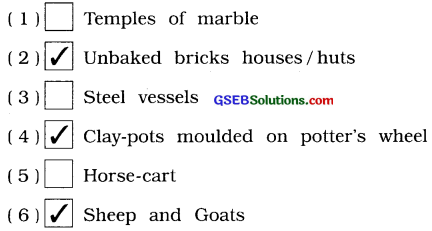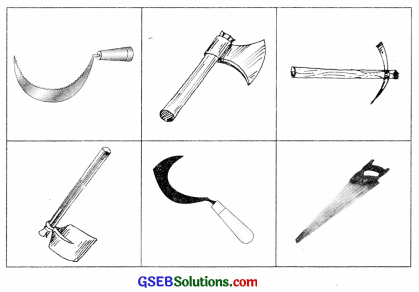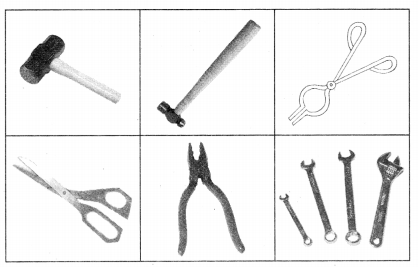Gujarat Board GSEB Solutions Class 6 Social Science Chapter 4 Beginning of Human Life Textbook Exercise Important Questions and Answers, Notes Pdf.
Gujarat Board Textbook Solutions Class 6 Social Science Chapter 4 Beginning of Human Life
GSEB Class 6 Social Science Beginning of Human Life Textbook Questions and Answers
Question 1.
Study the map of India given in textbook, page no. 21 and locate Bhimbetka, Hallur, Karnul and Mahagarh. In which state of India would you find these ancient places today?
Answer:
Today, Bhimbetka is located in Madhya Pradesh, Hallur is in Karnataka, Karnul is in Andhra Pradesh and Mahagarh is in Uttar Pradesh.
2. Answer the following questions:
Question 1.
Why did primitive man live in caves ?
Answer:
The primitive man lived in caves to protect himself from wild animals, cold and rain.
![]()
Question 2.
What were the uses of fire for primitive man ? How is fire useful to us ?
Answer:
The primitive man used fire for the following purposes:
- to cook flesh of hunted animals
- to drive away wild animals by lighting the fire in front of caves
- to keep the cave lighted and
- to get protection from cold.
Today we use fire for heating water, preparing hot drinks and cooking, lighting lamps in the house, for running railways and steam engines by producing steam from water.
Question 3.
In how many stages have the historians divided the life of early man ? Name them. OR Which are the main stages of early man’s life?
Answer:
The early man’s life is divided into three main stages:
- Old Stone Age (Hunters and Gatherers Stage)
- Middle Stone Age and
- New Stone Age (Farmers Stage).
Question 4.
Which tools were made with stone by early man ?
Answer:
The early man prepared different types of tools from stone:
- the tools for cutting and crushing the things
- tools for removing skin of animals and bark of the trees
- spears
- axe
- tools for digging out tuberous root and
- bows and arrows.
Question 5.
Why is the invention of the wheel considered the most revolutionary invention in the life of early man ?
Answer:
After the invention of wheel, the early man made vehicles like bullock-cart, horse-carriage, camel-cart, etc. and started using animals to pull them. As a result of these vehicles, the life of early man became easy; travel and transportation of goods became speedy. Time was saved as travelling on foot came to an end. As a result, the early man started thinking in new ways. Therefore, the invention of wheel is considered to be the most revolutionary invention in the life of early man.
3. Tick the things that were familiar to the people of the Harappan Civilization from the list given below:
Answer:

![]()
GSEB Class 6 Social Science Beginning of Human Life Intext Questions and Answers
Question 1.
If you are not allowed the use of fire in today’s world, which facilities will you not be able to get ?
Answer:
If we are not allowed the use of fire in today’s world, the following things will not be available to us:
- Delicious cooked food
- The trains running with steam engines and different industries
- Thermal electricity
- Electricity in houses, roads and public places
- Minerals from mines and
- Heaters protecting against cold.
Question 2.
Can food be cooked without fire in our kitchens ? What will be our diet then ?
Answer:
No, it is not possible to cook food without fire, in our kitchens. Our diet will be in raw state without fire.
Question 3.
Can you think of a single day in the year when fire is not used in your kitchen?
Answer:
The fire is not used in the kitchen on the seventh day of the dark fortnight of the month ‘Shravan’, which is known as ‘Shitla Satam’.
Question 4.
List down the sources of fire that are used in kitchens today.
Answer:
The fire to cook food in the kitchen today is obtained from fuel, coal, cow-dungs, cooking gas (LPG), etc.
Question 5.
Do you think that there would be any vehicle in today’s world, if the wheel was not invented ?
Answer:
No, the vehicles would not have existed without wheel in modern times.
Question 6.
What would have happened if the wheel had not been invented ?
Answer:
The vehicles like bullock-cart, horse-carriage and camel-cart would not have existed, if the wheel was not invented. Modern vehicles of transportation like railways, motor car, bus, truck, aeroplane, etc. would not have been seen. Small or big machines would not have been manufactured. Speedy travel and transportation of goods would not have been possible. Our life would not have been easy in the absence of wheel.
![]()
Question 7.
What changes would have come in early man’s life because of the invention of the wheel ?
Answer:
After the invention of wheel, the early man made vehicles like bullock-cart, horse-carriage, camel-cart, etc. and started using animals to pull them. As a result of these vehicles, the life of early man became easy; travel and transportation of goods became speedy. Time was saved as travelling on foot came to an end. As a result, the early man started thinking in new ways. Therefore, the invention of wheel is considered to be the most revolutionary invention in the life of early man.
Question 8.
Why did people rear cattle in primitive stone age?
Answer:
The people of primitive stone age reared animals for the purpose of transportation and getting skin of animals for leather.
Question 9.
How are the animals useful to us today ?
Answer:
The animals are useful to us today for farming, transportation of goods, travelling and for getting milk, leather and wool.
Question 10.
Why did early man choose to live in the caves of mountains and on the banks of rivers ?
Answer:
The early man might have chosen the caves of mountains to protect himself against wild animals and cold.
The early man might have chosen the banks of rivers for getting water, to live collectively by building shelters and for agriculture and rearing animals.
![]()
Activities
1. Draw the tools of ancient time and modern time.
2. Make a list of the activities done by the people of Stone Age.
3. List down the ways in which primitive man used the different pans of a tree.
Answer:
1. Draw the pictures of ‘tools of primitive man’ given on page no. 19 of the textbook. in your notebook.
Tools used in modern time:


2. People of Stone Age performed the following activities:
- to store grains,
- to hunt animals, fish and birds for food,
- to collect fruits, flowers and leaves of trees for food,
- to prepare wheels from the trunk of tree and prepare vehicles like carts,
- to prepare different tools of stone,
- to draw pictures of animals on the walls of caves
- to prepare clay-pots on the potter’s wheel and
- to prepare metal pots.
3. Primitive Man used different parts of vegetation for the following:
- leaves, flowers and fruits of vegetation for food and medicine,
- the branch of tree as the handle of an axe made of stone,
- to prepare spears and bows-arrows out of the branches of tree,
- to light fire from the wood obtained from trees,
- to prepare wheels from the trunk of trees,
- to prepare huts and shelters from the wood of trees.
GSEB Class 6 Social Science Beginning of Human Life Additional Important Questions and Answers
Choose the correct alternative from those given below each question:
Question 1.
In search of what did the early man wander from place to place ?
A. For new place of habitation
B. For tools
C. For tame animals
D. For food
Answer:
D. For food
![]()
Question 2.
From where do we get most of the information about the early life of early man ?
A. From tools
B. From habitation
C. From caves
D. From food
Answer:
D. From tools
Question 3.
Which is the most revolutionary invention of human life ?
A. Fire
B. Wheel
C. Farming
D. Habitation
Answer:
B. Wheel
Question 4.
Which types of pictures are seen in the caves of Madhya Pradesh and south of Uttar Pradesh ?
A. Utensils of clay
B. Children
C. Tame animals
D. Wild animals
Answer:
D. Wild animals
Question 5.
The living places of which stone age are found on the river-side regions ?
A. Primitive
B. Middle
C. Laghu (small)
D. Guru (big)
Answer:
C. Laghu (small)
Fill in the blanks with proper words or figures in the following statements:
1. The primitive man was a hunter and a ……………. .
Answer:
gatherer
2. The information about ………………. is available from the tools of stone and wood made by the primitive man.
Answer:
activities
![]()
3. The primitive man made some tools like …………….. and …………….. by binding with sticks.
Answer:
spears, bows and arrows
4. The invention of ………………. is the most revolutionary invention of human life.
Answer:
wheel
5. The primitive man started use of ………………. for running vehicles as a result of invention of wheel.
Answer:
animals
6. The workshop and the habitation of primitive mah are always found on ……………….. or in ……………………
Answer:
river banks, caves
7. The evidences of residences of primitive man are found in ………………. caves in the river valley region of Narmada.
Answer:
Bhimbetka
8. Major changes in world’s atmosphere took place before approximately ………………. years.
Answer:
12,000
![]()
9. The increase in the knowledge of primitive man about life, led him to ‘ ………………… ’.
Answer:
socialization
10. With the increase of intelligence of primitive man, …………………. developed in him.
Answer:
skill
State whether the following statements are true or false:
1. The remnants of human life are found in the continent of Asia since approximately 20 lakh years.
Answer:
False
2. New Stone Age is considered to be Farmers stage.
Answer:
True
3. The primitive man prepared tools from iron for his own use.
Answer:
False
4. The evidences of ash are also found from the place where the remnants of primitive man’s habitation are found.
Answer:
True
![]()
5. The invention of fire is the most revolutionary invention of human life.
Answer:
False
6. The primitive man made use of caves for living.
Answer:
True
7. The increase in the mutual co-operation of the primitive man led to the skill of communication by developing the language.
Answer:
True
8. The people of around 4th century B.C. lived in houses of bricks.
Answer:
False
Match the pairs correctly:
| SECTION ‘A’ | SECTION ‘B’ |
| 1. Old stone age | 1. animals |
| 2. New stone age | 2. Sabarmati region |
| 3. Paintings of cave | 3. Hunters and Gatherers stage |
| 4. Amarapur | 4. Farmers stage |
| 5. Mahi River region |
Answer:
(1 – 3), (2 – 4), (3 – 1), (4 – 5).
![]()
Answer the following questions in one or two sentences:
Question 1.
Why did the primitive man wander from place to place ?
Answer:
The primitive man wandered from place to place 1 in search of food.
Question 2.
From what do we get the information of initial life of primitive man?
Answer:
We get the information about the initial life and activities of the primitive man from his tools.
Question 3.
From which materials did the primitive man make his tools ?
Answer:
The primitive man made his tools from stone and wood.
Question 4.
For what purpose did the primitive man use his tools ?
Answer:
The primitive man used his tools for hunting, making residence or some other facilities.
Question 5.
How do we come to know about the primitive man’s knowledge of lighting fire?
Answer:
The remnants of ash are found from the places where the primitive man lived. We come to know from this, that the primitive man might have had the knowledge of lighting fire.
![]()
Question 6.
Which is the most revolutionary invention of the primitive man ?
Answer:
The most revolutionary invention of the primitive man is the invention of wheel.
Question 7.
When did the primitive man use vehicles ? How ?
Answer:
The primitive man used vehicles after the invention of wheel. He started using tame animals for different forms of transport.
Question 8.
How do we come to know that the primitive man started using tame animals for running vehicles?
Answer:
We come to know about the use of animals for running vehicles, from the cave paintings.
Question 9.
Which things are found from ‘the workshops or factory sites of primitive man’ ?
Answer:
Big pieces of stone, the tools left by the primitive man and the tools which were not well-prepared are found from ‘the workshops or factory sites of primitive man’.
Question 10.
In which caves are the paintings of wild animals seen ?
Answer:
The paintings of wild animals are seen in the caves of Madhya Pradesh and Uttar Pradesh.
Question 11.
In which caves are the evidences of primitive man’s habitation found ?
Answer:
The evidences of primitive man’s habitation are found in the caves of Bhimbetka of river Narmada, Caves of Vindhya mountains and South Indian mountains.
![]()
Question 12.
What is the result of primitive man’s mutual living ?
Answer:
The mutual living of primitive man led to increase in socialization, use of signs, symbols and gestures and the development of language.
Question 13.
From where are the remains of human and animal skeletons found ?
Answer:
The remains of human and animal skeletons are found from the land at Langhanaj and Akhaj villages in the Sabarmati river region and Amarapur of Mahi river side region.
Answer the following questions in short:
Question 1
What did the primitive man eat ?
Answer:
The primitive man was a hunter and a gathers used. He hunted animals, fish and birds and ate their raw meat. He also roots, leaves, fruits and flowers from various trees as food.
Question 2.
Where did the primitive man prepare the tools of stone ?
Answer:
The tools of stone were very useful for the primitive man. Therefore, he found out the places from where he could get good quality of stone. The places which can be called as ‘the workshop of primitive man’ are found. The tools, which he had prepared and left or not prepared well, are also found. Such workshops and residences most probably were found either on the river banks or caves.
Question 3.
Which civilization is known as ancient ‘Harappan Civilization’ ?
Answer:
People in the middle of 4th century B.C. lived in the houses of clay (Kuccha). They reared sheep and goats. They made clay pots on the wheel of potter, painted them and made metal-bronze pots. This human civilization is known as ancient ‘Harappan Civilization’.
Answer the following questions:
Question 1.
What were the effects of climatic change on human life?
Answer:
There were major changes in the world’s climate around 12 thousand years ago. As a result, the heat increased. The herbivorous and carnivorous animals increased in number. The knowledge about these animals also increased in mankind. Therefore, people started taming herbivorous animals.
At many places in India, the natural growth of wheat, barley, etc. was witnessed. People stored these grains for food. People started meeting each other quite often, which increased socialization. Therefore, signs, gestures, artistic symbols and language developed.
![]()
Question 2.
What changes took place in the life of the ancient man due to civilization?
Answer:
The following changes took place in the life of ancient man due to civilization:
- He gradually stepped towards modernization.
- Increase in intelligence developed skills in him.
- The knowledge of hunting some animals and taming some animals developed in him.
- He learnt representation by some signs, artistic symbols and gestures.
- He learnt the art of sowing and reaping the grains.